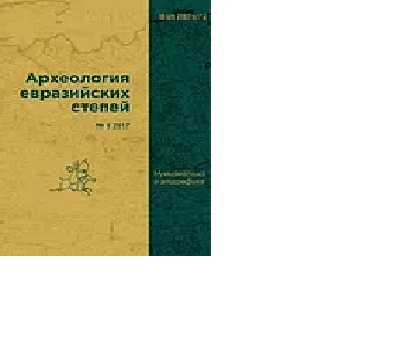COUNTERMARKED PULS DATED 14TH CENTURY FROM ISKE-KAZAN
Keywords:
Golden Horde, numismatics, pul, countermarking, Iske-Kazan, 14th centuryAbstract
This is the next work in the series of articles by the authors on the publishing of numismatic material from Iske-Kazan archaeological complex is dedicated to 14th century copper coins. This block of material consisting of 297 pools is subdivided into the following two parts: non-countermarked and countermarked puls. According to the calculations made by the authors, the first part comprises puls dating back to the period from 721 to the early 800s A.H. Countermarked coins, constituting one third of the entire complex, are subdivided on the basis of countermark types. Numismatic materials from Bolgar settlement are used for comparison. The article features a comparison of the occurrence of countermark types at Blgar and Iske-Kazan settlements. It was determined that the number of coins with Khan countermarks at the Iske-Kazan site exceeds that at the Bolgar site. It is still difficult to make an
unambiguous conclusion on the reasons for this situation on the basis of the conducted research. Similar difficulties are associated with the lack of systematic excavations in the territory of Iske-Kazan archaeological site, the availability of a small numismatic basis for statistical research, the polyvariety of reasons (the coins were possibly countermarked in Iske-Kazan; in a particular historical situation the population of medieval Bolgar, where puls were countermarked with the word Khan at the time, migrated to the Iske-Kazan region, etc.). It has been established that the distribution of countermarks studied in the article was a single nature for Bolgar settlement regardless of whether they were discovered during the excavations of 1946-1958, or the excavation of 2014. In other words, the distribution is not random, but consistent.
References
Бугарчев А.И., Сивицкий М.В. Археологические и нумизматические находки из раскопа CLXXXV Болгарского городища // Поволжская археология. 2016. №4 (18). С. 202–225.
Бугарчев А.И., Степанов О.В. Нумизматические материалы X – начала XIV вв. с территории Иске-Казанского комплекса (Татарстан) // Нумизматика Золотой Орды. 2015. №5. С. 55–60.
Бугарчев А.И., Степанов О.В. Джучидские монеты ханов XV в. из находок на территории Иске-Казанского археологического комплекса (Татарстан) // Нумизматика Золотой Орды. 2016. №6. С. 98–102.
Мухаметшин Д.Г., Федорова Е.А. Нумизматический материал из Болгар по итогам раскопок 2014 г.// Нумизматика Золотой Орды. 2016. №6. С. 18–32.
Сизганов А.А. Сравнительный поштемпельный анализ пулов Хызр-хана чеканки Гюлистана с Булгарского и нижневолжских городищ // Труды Международных нумизматических конференций «Монетное дело и денежное обращение в монгольских государствах XIII–XV веков». IV МНК-Болгар 2005, V МНК-Волгоград 2006. М.: «Нумизматическая Литература», 2008. С. 137–141.
Степанов О.В., Бугарчев А.И. Об одной группе булгарских монет второй четверти XV в. // Нумизматические чтения Государственного Исторического музея 2015 года. М., 2015. С. 106–109.
Федоров-Давыдов Г.А. Нумизматика Хорезма золотоордынского периода // Нумизматика и эпиграфика. Т. V. 1965. С. 179–224: илл., карта.
Янина С.А. Общий обзор коллекции джучидских монет из раскопок и сборов Куйбышевской археологической экспедиции в Болгарах (1946–1958 гг.) // МИА. 1962. №111. С. 153–178.

Downloads
Published
How to Cite
Issue
Section
License
Copyright (c) 2017 A.I. Bugarchev, O.V. Stepanov

This work is licensed under a Creative Commons Attribution-NonCommercial 4.0 International License.







